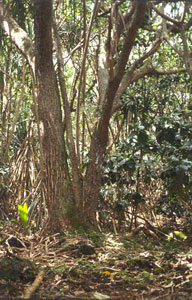Noni (Morinda citrifolia)
is believed to be among the original “canoe plants”
that Hawaii’s Polynesian colonizers brought with them
in their voyaging canoes. The voyagers valued the plant for
its medicine and dyes.
Since the early days of the colonizers noni has become naturalized
on all the main Hawaiian islands. It grows naturally where it
is relatively wet to moderately wet, from sea level to about
1500 feet elevation. It can be found near the coast, in open
lowlands and grasslands, in gulches, as an early colonizing
plant specie in recent lava flows, in disturbed forests of the
dryer areas, such as the lowland forests in which hala (Pandanus odoratissimus)
and kukui nut (Aleurites moluccana) trees grow. It tolerates
salinity and thrives within solution pits, or inland tide pools
in which brackish water (ocean water mixed with fresh water)
is found.
Photographs: S. C. Nelson |
 |
1. Lava flows
Noni is one of the first dicotyledenous plants to colonize low-elevation
lava flows on the Big Island. |
 |
 |
Above, young noni plants
are growing from cracks in the 1980’s-era lava flow near
Kalapana in the Puna district of the Big Island. The lava flow
hardened into a basaltic sheet several or more feet think at
this location. LEFT: windswept noni plant bearing ripe fruit.
The Pacific Ocean is on the horizon. RIGHT: Young plant emerging
from a crack in the lava field (close up of stem shown below).
The edge of the lava flow is visible in the far background,
near the top edge of the photograph.
|

This is a close-up of the stem of a Morinda citrifolia
plant emerging from a crack in the lava. Noni seeds were presumably
dropped into the cracks by birds, rodents or humans. Ancient
Hawaiians seeded lava cracks with various kinds of drought-resistant
plants or crops such as noni and coconut. Noni may also become
established in cracks within asphalt or cement.
|

Noni, ferns and grasses are some of the first plant species
in Hawaii to colonize lava flows. This plant was found growing
in a lava field near Kailua-Kona, on the island of Hawaii. |

Wild noni plant found growing in a lava field near Kailua-Kona,
on the Big Island of Hawaii. The lava flow at this location
is probably several meters thick or more. Rainfall at this location
is minimal, probably less than 10 inches per year.
|

Roadside noni in lava, Chain of Craters Road (Hawaii Volcanoes National Park, island of Hawaii)
|

Noni in cracked lava, Chain of Craters Road (Hawaii Volcanoes National Park, island of Hawaii)
|

Noni growing in hardened lava flow, Chain of Craters Road (Hawaii Volcanoes National Park, island of Hawaii)
|
Noni can grow and thrive under conditions in which few other plants can survive. |

Fresh lava flow at Chain of Craters Road in November 2004 (Hawaii Volcanoes National Park, island of Hawaii)
|

Fresh lava flow at Chain of Craters Road in November 2004 (Hawaii Volcanoes National Park, island of Hawaii)
|

Noni is a common lowland roadside plant in Hawaii, often occurring
along the highways that cut through lava fields. This large
plant is near the Kailua-Kona airport on the Big Island of Hawaii.
The Pacific Ocean and a lava field, looking west, is visible
in the background. |
 |
2. Tide pools |

A Morinda citrifolia plant is growing within the brackish water
of an inland tide pool near sea level in the Opihikao area of
the Big Island of Hawaii. Noni plants are extremely salt tolerant.
The salty, brackish water level at this location rises and subsides
each day, according to the tides, filling up or emptying the
tide pools. |

A mature noni plant (Morinda citrifolia) is growing in an inland,
brackish tide pool on the Big Island of Hawaii. The tide pool
is approximately 500 meters from shoreline. The brackish water
rises up from beneath the ground every day at high tide. As
the rising tide mixes with the fresh groundwater, a brackish
mixture is created. In addition, this water is heated from the
active lava beneath the surface. The Hawaiians would come to
this location to soak in the warm, brackish water that was filled
with fallen noni fruits. Apparently, there was some medicinal
benefit realized from this practice.
|

Noni plants growing in and around a beautiful inland tide pool
in the Puna district of the Big Island of Hawaii. The water
is very brackish. |
 |
3. Forests |

Noni trees are forest understory plants in disturbed and native
forests near the coastlines of Hawaii. Here, a good-sized noni
plant (right) is dwarfed by a kukui nut tree (center). Hala
plants (pandanus) are visible in the background. |

Noni (background) and hala plants (foreground) are common companions
in Hawaii’s coastline forests. |

This old noni plant is growing within the foundations of an
ancient Hawaiian homestead. The stem diameter is approximately
12 inches. The rocks in this photograph once formed the walls
of a Hawaiian house, which stood in a community of houses near
the coastline of the lower Puna district on the Big Island of
Hawaii. |
 |
4. Gulches |
| Noni is a common river
or stream gulch plant along the Hamakua coast of the island
of Hawaii, and along gulches of all the main Hawaiian islands. |
| Back to Top |

